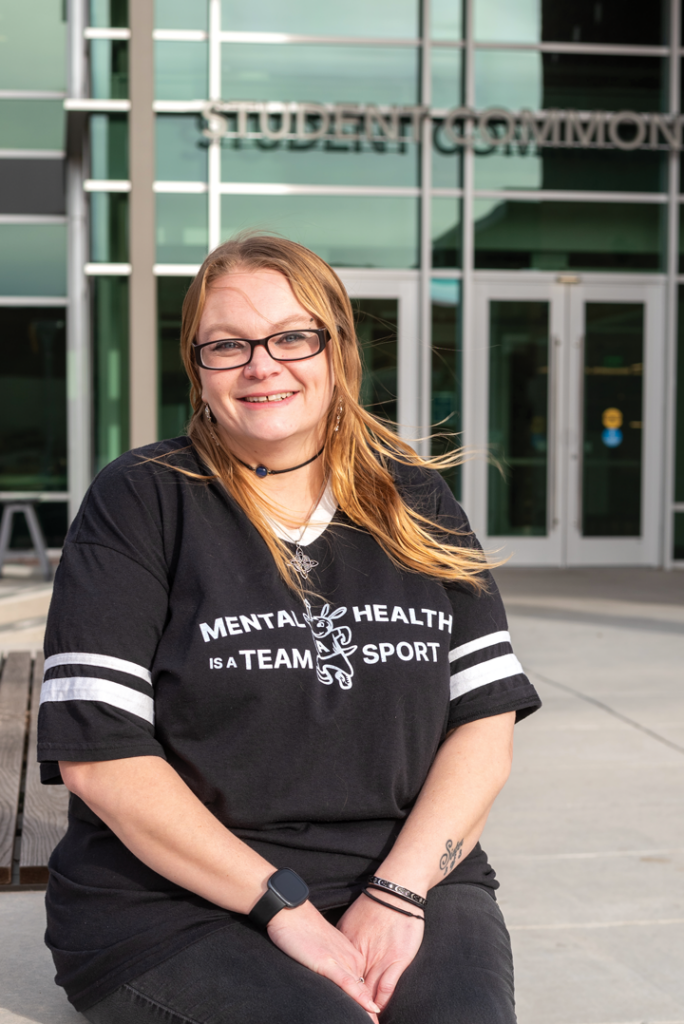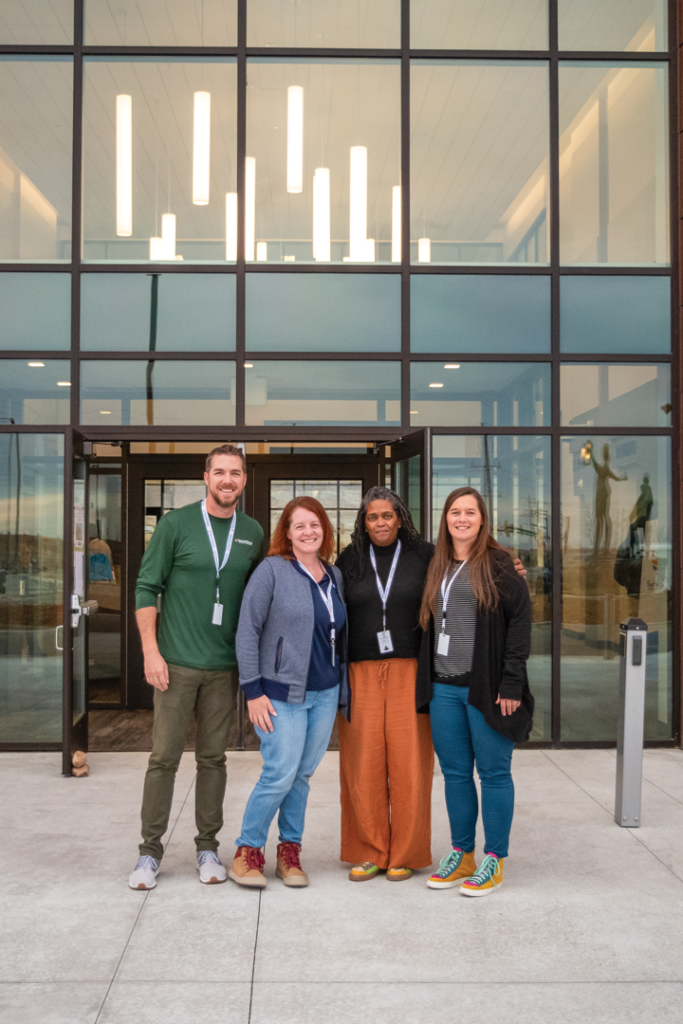Danielle Irwin relapsed in an attempt to shield herself from the pain of losing one of her best friends to meth. But her friend’s passing also made her wonder if she should quit for good.
High school was quite a few years ago for Irwin, and it was a blurry mess in her brain, like a smudge on a glass table she couldn’t clean. When she went to Aims Community College back in 2011, it didn’t go so well. She smoked meth in between classes to stay awake, especially before math.
“I felt like I was doing a great job back then,” she says and laughs.
At the time, her life felt like one of the dead-end dirt roads she used to travel in Keenesburg so she could smoke meth in private. She really wanted to go back to school and do something other than housekeeping during her long night shifts in a nursing home. So, she decided to give it another try.

Danielle Irwin, CRLA Leader. Photo by Jordan Secher.
Irwin, now 33, is attending Aims once again. She is also part of the Collegiate Recovery Leadership Academy (CRLA), a national fellowship program aimed at encouraging students to lead recovery efforts on campus. Only 50 fellows are selected by the academy nationwide each year.
Irwin was a fellow last year, and this year, as a leader, she supports Jennifer Daniel, another Aims student who is in recovery. One of Daniel’s recent projects was the “Little Book of Recovery,” a collection of poems, artwork and stories from students in recovery or who have recovering loved ones. Her book will be published this spring when she graduates with an associate’s degree in psychology. She hopes to one day become a substance abuse counselor.
Aims is a main contributor to opioid recovery and prevention in Northern Colorado, thanks in part to Irwin and Daniel. The college’s student life director, Janet Chase, calls Aims’ extensive recovery efforts “student-driven,” though she’s also pushed the efforts herself after years of frustrating dead ends from former administrations, making her even more grateful for her current bosses’ support. Aims focuses on opioid education and support from student life and has many kiosks where people can get free Narcan, a nasal spray administered to reverse the effects of an opioid overdose, especially if the person isn’t breathing.
The community college is a good example of the concerted effort by many organizations to make a dent in the opioid crisis. Irwin is honored to be a part of it.
When Irwin overcame her addiction in 2019, not long after her friend died, she had to isolate herself from friends who used and instead leaned on her parents for support, even though they weren’t close at the time.
She also credits the community for the support she received when she got sober. For example, her next-door neighbor would pop his head in every day to check on her as she battled withdrawals.
“I really wish I had the support that’s here now,” Irwin says of Aims. “We can help reduce the stigma surrounding addicts and spread awareness. Students are great motivators for each other. They don’t listen to adults anymore. Little by little, if we can educate one person, that creates a spark.”
Settlement money funds community resources
Buoyed by a surge of funding from opioid settlements, treatment centers and supportive nonprofits are now better equipped to slow the tide of addictions and overdoses, even as the numbers continue to look grim. More than 50 residents in Weld County died from an opioid overdose in 2022, both in the form of prescriptions and, mostly, synthetics from the streets, according to the Weld County Health Department. Close to 6,000 opioid-related deaths were reported in Colorado in the last 10 years. In 2021 and 2022 combined, there were more than 1,400.
Yet even those dark numbers represent hope: The number of deaths in Weld County decreased in 2022 (down from 68 in 2021), and it went down statewide too. Awareness about the dangers of opioids, including the fact that sometimes people aren’t even aware they are taking them, has reached the general public.
“The community is clamoring for these tools because they realize there’s a serious issue here,” says MJ Jorgensen, director of addiction response for North Colorado Health Alliance, “and that’s refreshing. We don’t say ‘refreshing’ very often in this line of work.”
Colorado will receive $700 million in settlements from lawsuits with businesses that sold prescription opioids as well as those that made and distributed them. More than $450 million will go to regional councils in the next 18 years, according to the state. Weld County is expected to receive more than $16 million, and Larimer County will receive an estimated $26 million. The money will be dispersed by the regional councils to agencies and programs aimed at addressing the crisis. It has already reached places such as North Range Behavioral Health and the North Colorado Health Alliance.
The funds are a blessing and some much-needed ammunition against opioids, says Eric Aakko, director of the communications division for the Weld County Department of Public Health and Environment. He’s also the chair of the Weld region council that will disperse the settlement money.
Weld’s health department knew of the crisis for years, if not decades, but it lacked the resources to put out any meaningful messaging or programs until recently.
“We didn’t have the staff or the resources for that,” Aakko says.
The department has since hired a staff member just to work on opioid prevention. Aakko hopes to spread the word about the dangers of opioids before they get in the hands of those who may develop addictions to them.
“We want to start working in schools,” Aakko says. “That’s where prevention is key.”
The money is especially important because, as Aakko hinted at, funding for mental health and addiction treatment is sparse, partially due to the stigma attached to both. The funds are already helping facilities respond to addicts who need help as soon as possible. They’ve done so by hiring more staff (there’s a serious shortage of addiction counselors across the country), and the money will help organizations recruit and retain them.
“We now have a fleet of peer recovery support,” Jorgensen says of North Colorado Health Alliance, “and that’s the secret sauce in helping people feel supported and engaged.”
The money also means facilities can expand their hours and ability to take walk-ins instead of putting them on a waiting list.
“We’ve reduced barriers to help get people in more quickly and start that recovery process as soon as possible,” says Jennifer Miller, program director of integrated care for North Range Behavioral Health in Greeley.
“It’s really hard for someone to finally admit they need help and then have to wait a couple of days. We know, at that moment, they are at their highest need.”

Longview Campus staff from left: Brian Ferrans, deputy executive director; Kristi Shattuck, director of nursing; Lesley Brooks, executive/medical director; Cassie Damato, director of acute services. Photo by Jordan Secher.
New ways to treat addiction
In December, Larimer County opened the Acute Care Behavioral Health Facility at the Longview Campus in west Fort Collins in partnership with SummitStone Health. It was funded by a 20-year county ballot initiative that uses a sales tax to provide behavioral health services. The facility is Larimer County’s first to offer beds for addicts fighting through withdrawal symptoms, commonly referred to as “detox centers.”
This is significant for opioid addicts: Many experts say the withdrawal symptoms are the most painful they’ve treated in decades of addiction care, often to the point where many are too afraid to quit.
“They are in crisis. I don’t want to downplay it. It’ll be huge,” says Lesley Brooks, assistant medical director for North Colorado Health Alliance and chief of addiction medicine for SummitStone, of the Acute Care Facility. “We are picking people up at the bottom of the river.”
It’s also significant in the sense that it’s an acute care center for any mental health crisis. In other words, it’s not just for addicts. Drug treatments have changed through the years, and this facility is a reflection of that.
“Mental health and addiction don’t live in different systems,” Brooks says. “This isn’t rocket science.”
Brooks and other health care workers have known that many addicts use drugs to numb trauma or resolve anxiety or other mental health problems, but only in the last few years have addiction programs worked to address both issues. One reason, Brooks says, was money. They had to separate the two for insurance purposes.
Poor mental health and addiction are now, in some cases, finally being seen as one problem.
“You usually do find there is some sort of underlying mental health concern,” Miller says. “You need to address both in order to address the addiction. As long as I have been here, we have treated the whole person.”
North Colorado Health Alliance has also treated the whole person for years, and that’s part of the reason Jorgensen (they/them) has stayed there. Treating addicts with respect and dignity and without judgment has always been a big deal to Jorgensen. It’s a main reason they began working in addiction treatment in the first place: They are an alcoholic.
The stigma around addiction treatment continues to be the biggest hurdle in getting people to admit they have a problem and seek help, Jorgensen says.
“There was a compassion and care for people [at North Colorado Health Alliance] that I hadn’t seen in my education space,” they say. “Approaching people where they were at and building plans on what they wanted rather than what they needed had overwhelming success. It made me wonder why we weren’t doing this more.”
Jorgensen’s comment about peer specialists being the “secret sauce” is a reflection of the widely recognized belief in the addiction treatment world that former addicts are a key to helping current ones into recovery. North Range, for instance, will use some of the settlement money to create a youth opioid support team to support teens and their families who are struggling with opioid addiction, something that hasn’t been done before. The settlement funds will also allow the team to create individual treatment plans and home monitoring for both the addict and their family.
“Our hope is to make treatment more accessible for high-risk teens,” says Micaela Sanchez, director of marketing and community outreach for North Range, “while at the same time supporting their families through safety planning and family therapy.”
A final answer
When Janet Chase was an academic advisor for Aims back in 2005, she would take phone calls from parents asking what kind of support they offered for students struggling with addiction. Students would also admit they were struggling. She would have to give them all bad news.
“We didn’t have anything,” says Chase, who is now the director of student life. “Administrators weren’t supportive of it. They thought it would attract drug users.”
That changed as recently as 2022, when Chase formed a committee with Aims students to help their peers through their addictions. They’ve focused on harm reduction with educational materials and kiosks containing free Narcan. Greeley treatment facilities also have kiosks in many areas.
Chase doesn’t mind mixing in a little fun with the education. She advertises free pot to students, for example, and they’re handed a potted plant when they come into the student life office. She has recovered addicts speak to students about redemption and sobriety. She won’t, however, preach abstinence or try to scare students with “this is your brain on drugs” tactics.
“The old style of thinking doesn’t work,” Chase says of drug education. “D.A.R.E. doesn’t work.”
Aims is part of a statewide effort to target college students, led by organizations such as Blue Rising, which promotes the message, “You can’t outsmart fentanyl.” Colorado State University and University of Northern Colorado also work with Blue Rising.
Experts recognize that college is a time of experimentation, but they discourage students from using fentanyl since its potency kills a scary percentage of first-time users. They also want to raise awareness of fentanyl’s reach: Many drugs now are laced with it as a way for drug pushers to increase their sales, and synthetic fentanyl often looks like common painkillers or even candy.
Treatment workers refer to the rash of overdoses as fentanyl poisoning, and though exact numbers aren’t available (they don’t parse them out), they think poisonings are responsible for a significant portion of opioid deaths.
Aims now offers recovery meetings to students as well as free counseling services, both of which are resources that parents and students were clamoring for years ago. Chase feels a lot better about the options they now provide, but she gives most of the credit to students like Irwin and Daniel in the CRLA.
Daniel is in recovery and is six years sober, but opioids are still a big part of her life. She got hooked on them years ago after taking them for herniated discs in her back. Her mother now gives her doses of Advil to control the pain. Daniel admits it’s not enough to stop it.
“I just live with it now,” Daniel says, “and I work really hard.”
She is 30 and has three children ages 4,
8 and 9. She’s also a single mother. Her kids motivate her to stay clean.
“I’m the only thing my kids have,” Daniel says. “They deserve a better life.”
She and Irwin provide support to students with addictions because they didn’t have it when they were struggling.
“Danielle and I have talked about that,” Daniel says. “There was no one there saying, ‘Hey, you can get out of this.’ People have now told us that they have stopped using because of what we’re doing.”
But recovery remains hard. Daniel runs into users all the time, and she tries to help whoever she can. She has a formula for the people she cares about the most. It’s simple, but it often works.
“You be there for them,” Daniel says, “and love them unconditionally.”







